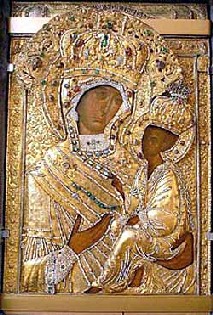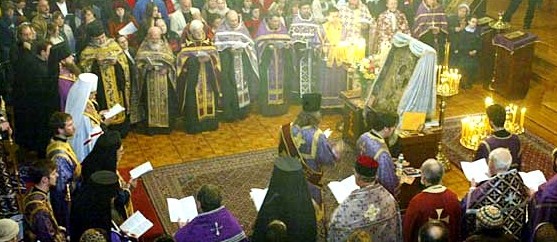

The miraculous Icon of the Mother of God of Tikhvin
 |
 |
The Tikhvin Icon of the Mother of God. The XVth century - According to tradition, the wonderworking Tikhvin Icon of the Mother of God is one of three painted by the hand of the Holy Apostle and Evangelist Luke. There is a wonderful legend about how this icon arrived in Russia. In 1383 it disappeared from the magnificent cathedral at Blachernae in Constantinople, which was built for it, so it was as if Our Lady Herself moved from Byzantium to Russia. During the reign of the Grand Prince of Moscow, Dimitry Donskoy, this wonderworking icon first appeared in the region of Novgorod. It appeared above the waters of Lake Ladoga, invisibly borne through the air by angels, shining with a radiant light. Many times the icon moved from place to place, healing the infirm and comforting those in sorrow. In those places where the icon stopped, pious Orthodox Christians built chapels and churches. She chose the small town of Tikhvin as her permanent place of shelter. There a church was soon built for the icon, and in time a monastery grew up around it which came to be known as the Great Tikhvin Monastery. The veneration of the icon was so great that a special window was built into the church, through which pilgrims could see the wonderworking icon and pray before it even when the church was locked. It is noteworthy that an unusual warmth issued from the hands of the Theotokos on the icon that could be felt by the lips of those who venerated it. A great number of city and monastery churches housed copies of the Tikhvin icon which themselves were glorified by miracles and were especially revered. At the end of the eighteenth century there was such a revered icon in the church of the Dormition of the Theotokos in Ekaterinburg. Apparently the city dwellers and pilgrims prayed so frequently and so earnestly before this icon that the church itself was often called “the church of the Tikhvin icon.” It was precisely this church which was destined to become the first church of the Novo-Tikhvin Convent. After the founding of the convent by the first Abbess, Mother Taisia, it received an exact copy of the famous wonderworking icon from the Great Tikhvin Monastery. Update - After 55 Years in U.S. the Icon of the Mother of God of Tikhvin goes home March 12, 2004 - Reported in the [newyorktimes.com]. Written by Michelle V. Agins. Heading Home, After 55 Years in U.S. The icon of the Mother of God of Tikhvin at the Cathedral of the Holy Virgin Protection goes home. The sad-eyed woman and the man-faced child have many tales to tell: fleeing the perils of World War II, astonishing fishermen by hovering over a lake, helping repulse armies, curing the sick. Now, after a 55-year stay in the United States - a fleck in its two-millennium story - comes the latest chapter for the miraculous icon of the Mother of God of Tikhvin. It is returning in July to its centuries-old home in Russia, a monastery in Tikhvin, near St. Petersburg. The icon arrived yesterday in New York City for three days of veneration and services. Beyond its long history, church officials and scholars see the icon as a potent symbol of Russian national feeling and the resurgence of the Russian Orthodox Church after communism's fall. Just as much, it is the story of how three generations of one family tended a revered religious symbol that was spirited away from the Soviet regime, and then kept a promise to give it back. "Many people told us that by now the icon is ours and you could do with it what you want, but we felt differently," said Alexandra Garklavs, the wife of the Orthodox priest in Chicago who has custody of the icon. "We thought if we could do something for our former fatherland, which suffered so much, let them have it. And may it help them." Mrs. Garklavs's husband, the Rev. Sergei Garklavs, drove the icon to New York, where it was received yesterday at the Cathedral of the Holy Virgin Protection in the East Village. The cathedral belongs to the now-multiethnic Orthodox Church in America, which was granted independence by the Russian church in 1970. Pilgrims and priests trickled into the church, prostrating themselves on a carpet before the icon and kissing the protective glass cover over the wooden case holding it. They prayed and lighted candles. A man carried a severely handicapped child up to the icon, which is painted on wood, measures 34 inches by 43 inches and weighs about 85 pounds in its case. One woman, Nelly Kartvelishvili, 52, came from Hoboken, N.J. She hugged Father Sergei. "Thank you, thank you, a million times, thank you," she said, weeping. A native of the former Soviet republic of Georgia, Ms. Kartvelishvili said the icon was always a symbol of hope during Communist persecution. "We had very hard times - he kept this icon," she said of Father Sergei. A prayer service was held last night to honor the icon. Today, it will travel uptown to St. Nicholas Cathedral on East 97th Street, the headquarters of the Russian Orthodox Church in the United States. The Russian patriarchate oversees its own 32 parishes in the United States. The Garklavs family spoke with ambivalence about parting with the icon, which depicts the Virgin Mary and baby Jesus and is protected by a jewel-encrusted covering made of gold-plated silver. The Rev. Alexander Garklavs, Father Sergei's son, said his father once compared the icon's departure to a child growing up. "There's a certain nostalgia, maybe a weeping of joy that your little babies are going off to college," Father Alexander said. "But at the same time there's a great deal of pride that they are coming of age." Father Sergei, 76, himself seemed reluctant to talk about his feelings at giving up the icon, which he has tended for 60 years. Having it was a joy but a great responsibility, he said, and giving it up is like losing a family member. "At the same time, it is a great honor," he said. The icon ended up in the Garklavs family during World War II, when the Germans took it from the monastery in Tikhvin to Riga, Latvia, where the bishop was John Garklavs. Bishop John ended up in a displaced persons camp in Germany at the war's end and cared for the icon there, displaying it for the faithful. A young man named Sergei - who was adopted by the bishop and became Father Sergei - helped lug it around starting at age 16. In 1949, the bishop immigrated to the United States, becoming bishop of Chicago in 1956, and kept the icon with him, always intending to return it to Russia once communism fell. Bishop John died in 1982 and stipulated in his will that his son, Father Sergei, send it back when the time was right. |